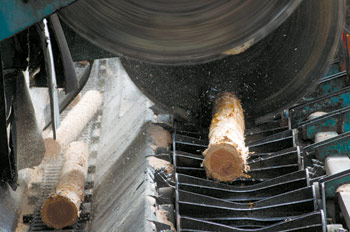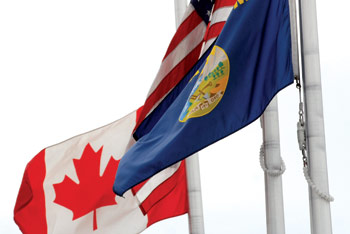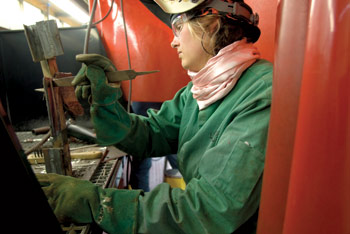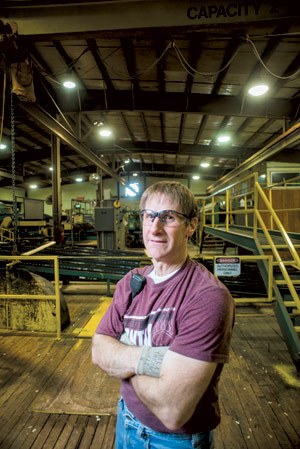The recession tore through Northwest Montana like a tornado, taking out sawmills, displacing families and leaving behind streets of abandoned storefronts. Unemployment rates soared above 20 percent. Life savings disappeared. When the dust finally began to settle, and recovery mercifully arrived, we were left staring at a new economic landscape. And we could see that the land we call home would never quite be the same again.
Even before the downturn, the region’s timber-dominated economy had for years been morphing into something many of our parents and grandparents wouldn’t recognize. Economists say nearly 50 percent of western Montana’s economic base in the late 1960s was directly related to forest products and associated services – agriculture may have reigned supreme out east, but timber was king in the west. Beginning in the late 1980s, however, the industry gradually eroded, which analysts attribute to various reasons but primarily limited timber availability on government lands, fueled by a changing society where more and more people view trees as amenities rather than commodities. Harvests plummeted and mills shut down. Many closed before and during the housing boom, then more shuttered in the recession, and a lot were in Northwest Montana: entire mills abandoned, disassembled and auctioned off in parts. These great machineries – longstanding symbols of an economic powerhouse – were suddenly gone, literally without a trace.
Today there are only a handful of operating mills and plants in the area, stretching from St. Regis to Seeley Lake to Columbia Falls – and several are run by Plum Creek, which faces fewer timber availability issues because it owns so much land. There are no mills in heavily forested Lincoln County. Other pivotal industrial facilities have gone dark as well. The Columbia Falls Aluminum Company, once an employer of 1,500 people and the lifeblood of a community, has been shuttered since 2009.
This is not the Flathead Valley of past generations or even of just six or seven years ago, before the recession punctuated the decay of some industries and encouraged the growth of other ones. The old economy had aluminum and timber and services of all sorts to support those industries. It had rough hands, hardened by rough labor. The new economy has gunmakers and Canadians; techies and geo-travelers. It has dragon boats, skiers and softer hands, more accustomed to holding smartphones than chainsaws. Both Whitefish Mountain Ski Resort and Glacier National Park reported soaring visitation numbers at a time when manufacturing plants were dropping off the map. Tourism grew stronger while big industry waned.
But to be sure, the new economy still has timber, which is enjoying a post-recession revival. Plum Creek, the region’s largest forest products company, reopened its Evergreen sawmill in March and has added more than 100 jobs across the Flathead in the last year. It now has 750 employees in Montana, down from its peak of 1,100 in 2007, though neither figure includes the many other people employed indirectly, such as contractor loggers and truck drivers. Plum Creek officials expect the current rebound to persist for years. Nobody, however, anticipates a return to the industry’s heyday. Barring some seismic shift in direction, or substantial progress in the biomass sector, the mills that are gone are gone forever. And a number of the workers who left are gone forever as well.
As we settle into economic recovery, it’s easy to measure what we lost in the recession, but it’s also possible to identify what we gained. If nothing else, the recession made us get creative. By depleting some of our core economic engines, it forced people across industries to come together and think differently. It opened new doors. University researchers and business leaders found themselves studying ideas like the economic role of lifestyle quality and conservation, the financial ripple effects of tourism, biomass viability, value-added manufacturing and city-specific target marketing. Tourism officials thought of new ways to attract income from key markets: all of a sudden buses in Chicago and Minneapolis had Montana billboards plastered on their sides. Crowd-drawing events like the Spartan Race and Montana Dragon Boat Festival provided much-needed economic sparks and are slated to return annually. Timber companies explored biomass and value-added niches; Plum Creek bounced back from a brutal lull in manufacturing by finding success in markets like architectural doors, specialty plywood and store displays. And where those niches failed to fill the valley’s manufacturing void, others picked up the slack, led by the emergence of firearms as a veritable manufacturing powerhouse. Technology companies either formed or expanded, including Vubiquity, one of the fastest-growing tech firms in North America. Health care continued to grow, and Kalispell further established itself as an important regional trade center. With the cards stacked against us, we learned to embrace adaptability as a guiding economic virtue.
 |
|
A saw in action at the Plum Creek mill in Evergreen. – File photo by Lido Vizzutti | Flathead Beacon |
The late University of Montana historian K. Ross Toole said Montana’s economy has often been defined by “boom and bust.” Though the recent housing collapse was the symptom of a national disease rather than a uniquely Montana affliction, it was nonetheless one more boom and bust in a long line of them for the Treasure State – from furs and gold to copper and now subdivisions. After previous busts, Montana’s resiliency has shone brightly. But the dynamics of an increasingly global economy raise interesting and hard questions for this rural state’s most recent recovery efforts. And we are once again forced to recall the old adage of placing all your eggs in one basket: an economy too reliant on housing faces the same risks as a community too dependent on aluminum. When the market crashes or the smelter shuts down, the boom gives way to the bust. But diversity can be an antidote. It can build up a foundation to withstand the busts.
“My overarching conclusion is that we should continue diversifying,” Kalispell Chamber of Commerce President Joe Unterreiner says. “Timber will still be a very large component of our economy. But we also need to continue to strengthen our position as a regional trade center and build up tourism and health care and other areas of the economy.”
Yet there is a flipside to diversification. Patrick Barkey, an economist and the director of the University of Montana’s Bureau of Business and Economic Research, says diversification indeed provides an “insurance policy” that lightens the blow when an industry collapses, but specialization – one dominant industry – usually generates higher wages. Detroit is the classic example. Though today it’s mired in bankruptcy, Detroit was once an affluent city enjoying the fruits of a high-paying and thriving auto industry.
“With diversity – a little of everything – you won’t have the size to command larger wages,” Barkey says, adding that the Flathead, because of its relatively small economy, is limited in how much it can diversify anyway.
Based on that thinking, Northwest Montana’s economic future may ride on finding a balance in which our increasingly diversified economy manages to retain or establish core industries that provide solid pay. Nobody wants Detroit. But everybody wants livable wages, which means nobody wants a strictly service-based economy either. Barkey says it’s important to remember that diversification can occur within existing industries as well, like when timber companies branch out into value-added manufacturing.
“Diversification can happen both between and within industries,” Barkey says. “That’s the direction we’re heading.”
Since achieving statehood in 1889 and even well before, Montana has been a land of resource extraction: beaver pelts, metals, coal, timber. But it appears Northwest Montana’s natural resource glory days are behind us. Which is not to say that resource extraction, woven into our state’s fabric, is disappearing anytime soon. It’s just going to play a different role, and already has for some time – certainly in this corner of the state, tucked away from the oil boom, where timber’s influence is shrinking, tourism’s is expanding and mining is only a role player. The arc of regional economic trends over the past two decades spells out these changes, and current shifts hint at their persistence into the future.
Barkey says his research shows that timber is still the region’s top industry, accounting for 20 percent of Flathead County’s earnings. But tourism and the federal government are quickly closing the gap, even if the growth of the federal sector is uncertain because of Washington, D.C. budget concerns. Earnings are comprised of household income – wages, salaries and benefits – rather than revenue generated by businesses.
“Wood products is maybe a little bit ahead,” Barkey says. “But it’s slowly losing its No. 1 status.”
 |
|
Canadian, American and Montana flags are seen flying above National Parks Realty in Whitefish. – File photo by Lido Vizzutti | Flathead Beacon |
Statewide, federal civilian and military jobs represent the largest chunk of earnings at 31 percent, according to the economic bureau’s research. Energy and mining combined are second at nearly 20 percent. That means the federal government and energy sector account for half of earnings in Montana. Agriculture is next up, followed by nonresident travel, non-timber manufacturing and transportation. Wood products and paper now contribute only 3 percent of earnings across the state.
Those numbers, however, only factor earnings. An industry like agriculture, long described as Montana’s biggest, generates some $3.6 billion for the state economy annually, according to some figures. But Barkey says the industry produces comparatively little in wages because it’s mechanized and often family-run. And in the Flathead, agriculture is a much smaller piece of the pie than in central and eastern Montana.
The earnings measurement also fails to tell the whole story with tourism. Tourism, touted as the state’s second-largest industry and a major economic driver in Northwest Montana, contributed over $3.3 billion in total economic impact in 2011, according to the University of Montana Institute for Tourism and Recreation Research. That figure includes nearly $2.8 billion in nonresident travel expenditures. Tourism has also proven to be somewhat recession-proof, posting strong visitation and spending numbers during the downturn’s closing years.
One specific group of nonresidents could actually be credited for propping up the region’s fragile economy and leading the way out of the recession: Canadians. Toward the tail end of the recession, there were times when it felt as if parking lots held more Alberta license plates than Montana plates, and that remains true today. Not only are our northern neighbors vacationing and shopping here, they’re building houses and laying down roots, of the second-home variety.
Donna Townley, an economist at University of Lethbridge who focuses on Canadian tourism in the Flathead Valley, classifies Canadian visitors into two categories: tourists and homeowners. They are both attracted to the valley by favorable exchange rates, cheaper goods and Montana’s natural wonders, as well as local marketing efforts specifically targeted at them.
In recent years, businesses have started flying Canadian flags and implementing technology to process Canadian debit cards. Canadians return the favor by purchasing property, cars, appliances, groceries, clothes and everything else they need or desire, taking advantage of their elevated spending power and, often, thicker wallets. Some local retailers report that more than 30 percent of their business is Canadian, while hotels are often predominantly full of Canadians. Townley doesn’t think the Flathead’s economy would have bounced back when it did or as strong as it did without north-of-the-border visitors.
“There wouldn’t be a Target here, there wouldn’t be a Lowe’s here and there wouldn’t be a Cabela’s coming,” she says. “You need all that traffic and the traffic is coming from the north. The Canadians come year round.”
So we know that a lot of Canadians are spending a lot of money at a lot of Flathead businesses. What we don’t know is how long the exchange rate will be in their favor, though Townley says it doesn’t matter. Goods will still be cheaper here. Townley, who travels here to purchase appliances for her Alberta home, says she bought a stove in the Flathead for $599 that cost $1,399 in Canada: “same stove, same specs.” And Montana’s natural amenities won’t disappear no matter what the exchange rate is. Townley owns a second home in Whitefish and will pass it down to her children, a multi-generational plan shared by many other Albertans and British Columbians.
 |
|
Jackie Gambell works on her build up plate during a welding class at Flathead Valley Community College’s Lincoln County Campus in Libby. – File photo by Lido Vizzutti | Flathead Beacon |
“This is not a blip in the system; this is long term,” she says. “The Canadians are still going to come. They’re still going to bring their friends. They’re still going to buy property. We’re going to spend money in this valley until we die and our kids are going to spend money in this valley until they die.”
Along with nonresidents, other leading players in the Flathead’s recovering, diversifying economy are firearms manufacturers, an ever-expanding health care sector and improving residential and commercial real estate markets, which have cascading effects across industries, from loans and titles to building supplies and contractors. Kalispell Regional Healthcare is the largest employer in the county at well over 2,000 employees, including a growing stable of specialists with impressive out-of-state resumes. Hospital officials anticipate KRMC will continue developing into a health care destination, bringing outside dollars into the community.
Technology, which provides high-quality jobs, may be a dark horse in the valley’s growth. Economic development leaders tout the area’s potential as a tech hub, pointing to an already sturdy base: Applied Materials, ZaneRay Group, Nomad Global Communication Solutions, Old Town Creative. The list keeps growing. In the modern business world, innovative techies no longer have to set up shop in Silicon Valley or some other metropolitan area. They can do it right here, where a weekday may be divided between business and mountain biking. It’s an attractive proposition, and one that is dependent upon retaining open spaces. Michael Goguen, a highly successful Silicon Valley venture capitalist and part-time Whitefish resident, has said he believes the Flathead is ripe for a tech industry expansion. He has also committed millions of dollars to permanently protecting large swathes of forest from development, and preserving them for public use.
Some of the region’s tech firms cross over into manufacturing, a sector that has recently experienced substantial gains in both employment and wages. With the goal of providing skilled workers for this growing sector, Flathead Valley Community College was awarded over $3.6 million in federal grants last year, the bulk of which was aimed at training programs for manufacturing jobs. And, from building aerospace components to office furnishings to large-scale batteries to firearms, there are plenty of local manufacturing jobs. Indeed, as Barkey described, diversification can occur both between and within industries.
No matter how our economy grows, it appears we’ll at least have a proportionate workforce to fill out the jobs. That’s what the anecdotal evidence and raw data suggest. During the recession, hordes of able-bodied workers left for the oilfields or elsewhere in search of work. But at the Flathead Job Service, word of mouth indicates the recession refugees are returning home. Backing up that word of mouth are statistics that show the labor force is growing. And when they return, they’re finding jobs. Flathead County’s unemployment rate fell to 6.1 percent in July.
“This has been our best summer in a long time, across the board,” says Laura Gardner of the Flathead Job Service, adding that a week in August saw 500 job orders from employers, the most since October of 2007.
So where do we go from here? How far can Canadians and travelers take us? How much weight can gunmakers and dragon boats bear? And where does timber, the economy’s long-reigning king, fit into the puzzle? Its reign is already giving way to a more democratic system, in which more industries share larger pieces of the pie. Is there a point when diversity gives us diminishing returns? While forest products remain a cornerstone of the economy, studies that detail the economic value of retaining natural landscapes are getting more attention, adding another wrinkle to the longstanding debate over when to protect and when to consume our natural resources. How that debate plays out will help decide how the industry and overall regional economy move forward.
 |
|
After the Ksanka mill shuttered in 2009, Bob Garrison, who has worked in wood products since 1984, went to nursing school at Flathead Valley Community College before working at Costco. Garrison was hired to work at Plum Creek’s Evergreen sawmill after it reopened in March 2013. Lido Vizzutti | Flathead Beacon |
For now, timber’s immediate outlook appears relatively sunny. Tom Ray, Plum Creek’s vice president of Northwest resources and manufacturing, believes his industry’s revival will continue in the coming years. Construction data and demographics, Ray says, describe an ideal supply-and-demand scenario for new housing starts. With the market collapse fresh on everyone’s minds, Ray hopes the number of new housing starts evens out at a robust but sustainable rate, unlike the excess of the housing boom. But despite the short-term optimism, timber’s long-term health is an open question. Many in the industry have seen too much uncertainty to be confident in crystal balls.
Jerry Doty and Bob Garrison know too well the whims of the modern forest products industry. The two longtime mill workers both lost their jobs during the recession. Doty was working at Evergreen’s Plum Creek sawmill when it closed in 2009 and Garrison was at the Ksanka mill when it shuttered that same year. Garrison went to nursing school at Flathead Valley Community College but abandoned that path for a job at Costco. Doty also took classes at FVCC but had bills to pay and kids at home, so he ended up – like so many others in his position – heading out to the oilfields. He came back from Shelby when he secured a job at a local bear spray manufacturer.
Then the phone rang earlier this year and both men found themselves back where they feel most comfortable: in a sawmill. The March reopening of Plum Creek’s Evergreen mill carried both real economic importance and symbolic significance for a region steeped in timber tradition. For men like Doty and Garrison, it means they again have solid-paying jobs with good benefits. But they know others who left after the mills shut down and never returned. Garrison has worked in wood products since 1984, initially in the Tobacco Valley, where, he points out, there are no longer any mills. He’s watched a lot of mills go under.
“If they take away all the mills, what are we going to do?” Garrison says. “I love my job. This is what I do.”
Doty worries about locals without a college education earning livable wages. The oilfields can be difficult and dangerous, not to mention hard on families. What’s the local blue-collar alternative if timber continues declining and the aluminum plant stays closed? Where will these workers find reliable 9-to-5 jobs with good pay and benefits? Jobs at many of the emerging tech-based manufacturers typically require college degrees, more so than an aluminum smelter or a mine or a mill.
“I’m all for college, but it’s not for everybody,” Doty says. “We need something else in the valley to fill that void; something in manufacturing – semi-skilled jobs that they can make a living at.”
Part of the answer may lie in the Flathead’s diversifying manufacturing base, though Doty’s questions don’t come with easy answers. In the end, we might have more questions than answers, but the answers are starting to come. The new economy is beginning to take shape – the recession is behind us and we can see a land in transition. More and more, we are looking forward to what could be, though people like Doty and Garrison are certainly excused for looking back at what was. And while we won’t all agree on exactly how this new economy should look, we can all agree on this: It sure feels good to have the recession in our rearview mirror.